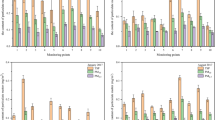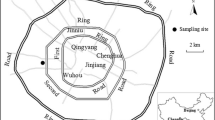Abstract
With the rapid development of the social economy and the frequent occurrence of haze, heavy metals in atmospheric particulates have been shown harmful to human health. In this paper, the samples of atmospheric particulate matter (PM10 and PM2.5) were collected in two typical sites of Tianjin in spring. The concentration of 6 heavy metals in PM10 and PM2.5 were analyzed by microwave digestion inductively coupled plasma mass spectrometry method. The enrichment factor (EF) method was used to identify the sources of heavy metals in particulate matter. The results showed that the daily average concentrations of PM10 and PM2.5 in Tianjin were notably influenced by building construction, traffic-related emission and meteorological condition. The heavy metals in the atmospheric particulate matter were as follows: ρ(Mn) > ρ(Pb) > ρ(Ni) > ρ(V) > ρ(Cd) > ρ(Co) and more easily enriched in fine particles PM2.5. The result of EF analysis suggested that the V, Mn, Co and Ni were not enriched, and the source of them in the atmospheric particulate matter samples was mainly nature. Cd and Pb were typical pollution elements in spring of Tianjin, and predominantly derived from human activities. Health risk assessment demonstrated that the carcinogenic risk levels of heavy metals in the atmospheric particulate matter samples were generally followed the order of men > women > children. Cd and Pb in the atmospheric particulate matter had no carcinogenesis risk. The potential carcinogenic risk of Ni was evaluated as acceptable and tolerable. This study could provide a scientific reference for the prevention and control of atmospheric particulate pollution.





Similar content being viewed by others
Availability of data and materials
All data generated or analyzed during this study are included in this published article and its supplementary information files.
Code Availability
Not applicable.
References
Ahmed M, Chin YH, Guo X, Zhao X (2017) Microwave assisted digestion followed by ICP-MS for determination of trace metals in atmospheric and lake ecosystem. J Environ Sci 55:1–10
Chen P, Zhang J, Bi XH (2016) Pollution Characteristics and Sources of Heavy Metals in PM 1o and PM2. 5 in Tianjin City. Acta Sci Nat Univ Nankaiensis 46:1–7
El-Araby EH, Abd El-Wahab M, Diab HM, El-Desouky TM, Mohsen M (2011) Assessment of Atmospheric heavy metal deposition in North Egypt aerosols using neutron activation analysis and optical emission inductively coupled plasma. Appl Radiat Isot 69:1506–1511
Esworthy R (2014) Air quality: EPA'S 2013 changes to the particulate matter (PM) standard. Library of Congress. Congressional Research Service
Feng QD, Dang Z, Lv XW, Ming CB, Tong YL, Li JH (2011) Chemical speciation distribution of heavy metals in atmospheric PM2.5. J Ecol Environ 020:1048–1052
Gaonkar CV, Kumar A, Matta VM, Kurian S (2020) Assessment of crustal element and trace metal concentrations in atmospheric particulate matter over a coastal city in the Eastern Arabian Sea. J Air Waste Manag Assoc 1995(70):78–92
Ghorani-Azam A, Riahi-Zanjani B, Balali-Mood M (2016) Effects of air pollution on human health and practical measures for prevention in Iran. J Res Med Sci 21:65
Hsu C, Chiang H, Lin S, Chen M, Lin T, Chen Y (2016) Elemental characterization and source apportionment of PM 10 and PM 2.5 in the western coastal area of central Taiwan. Sci Total Environ 541:1139–1150
Hu X, Zhang Y, Ding Z, Wang T, Lian H, Sun Y, Wu J (2012) Bioaccessibility and health risk of arsenic and heavy metals (Cd Co, Cr, Cu, Ni, Pb, Zn and Mn) in TSP and PM2.5 in Nanjing. China Atmos Environ 57:146–152
Karagulian F, Belis CA, Dora CFC, Prüss-Ustün AM, Bonjour S, Adair-Rohani H, Amann M (2015) Contributions to cities’ ambient particulate matter (PM): a systematic review of local source contributions at global level. Atmos Environ 120:475–483
Kim K, Kabir E, Kabir S (2015) A review on the human health impact of airborne particulate matter. Environ Int 74:136–143
Li WW, Li XH, Xu DQ (2011) Advances in the study on distribution characteristics and sources of heavy metals in atmospheric particulates. J Environ Health 28:654–657
Lin Z, Xi Z, Yang D (2005) Levels of air particulates with different diameters and the distribution of heavy metals in the particulates during the period of heating equipments used. J Environ Health 22:33–34
Liu P, Zhang Y, Wu T, Shen Z, Xu H (2019) Acid-extractable heavy metals in PM2.5 over Xi’an, China: seasonal distribution and meteorological influence. Environ Sci Pollut Res 26:34357–34367
Ma XL, Ren XQ, Liu JJ, Liu Y (2014) Study on distribution and source apportionment of heavy metals in atmospheric particulate matter in Gansu, Ningxia and Inner Mongolia sections of the Yellow River of China. Appl Mech Mater 675–677:363–366
Miller AJ, Raduma DM, George LA, Fry JL (2019) Source apportionment of trace elements and black carbon in an urban industrial area (Portland, Oregon). Atmos Pollut Res 10:784–794
Noh K, Thi LT, Jeong BR (2019) Particulate matter in the cultivation area may contaminate leafy vegetables with heavy metals above safe levels in Korea. Environ Sci Pollut Res 26:25762–25774
Ou J, Zheng L, Tang Q, Liu M, Zhang S (2022) Source analysis of heavy metals in atmospheric particulate matter in a mining city. Environ Geochem Health 44:979–991
Pastuszka JS, Rogula-Kozłowska W, Zajusz-Zubek E (2010) Characterization of PM10 and PM2.5 and associated heavy metals at the crossroads and urban background site in Zabrze, Upper Silesia, Poland, during the smog episodes. Environ Monit Assess 168:613–627
Schiff KC, Weisberg SB (1999) Iron as a reference element for determining trace metal enrichment in Southern California coastal shelf sediments. Mar Environ Res 48:161–176
Standards C, Standards F (2006) Ambient Air Quality Standards.
Sugimoto N, Shimizu A, Matsui I, Nishikawa M (2016) A method for estimating the fraction of mineral dust in particulate matter using PM2.5-to- PM10 ratio. Particuology 28:114–120
Tian Y, Li Y, Liang Y, Xue Q, Feng X, Feng Y (2021) Size distributions of source-specific risks of atmospheric heavy metals: an advanced method to quantify source contributions to size-segregated respiratory exposure. J Hazard Mater 407:124355
Wang J, Wang C, Chen ZL (2011) Heavy Metal pollution of PM10/PM2.5 near-surface in Guiyang. Environ Sci Technol 34:74–76
Wu Y, Li G, Yang Y, An T (2019) Pollution evaluation and health risk assessment of airborne toxic metals in both indoors and outdoors of the Pearl River Delta, China. Environ Res 179:108793
Wu W, Zhang M, Ding Y (2020) Exploring the effect of economic and environment factors on PM2.5 concentration: a case study of the Beijing-Tianjin-Hebei region. J Environ Manag 268:110703
Xu HH, Wang YS, Wen TX (2007) Size distributions and vertical distributions of metal elements of atmospheric Aerosol in Beijing. Environ Chem 26:675–679
Xu LZ, Batterman S, Chen F, Li JB, Zhong XF, Feng YJEA (2017) Spatiotemporal characteristics of PM2.5 and PM10 at urban and corresponding background sites in 23 cities in China. Sci Total Environ 599:2074–2084
Yang H, Zhang JQ, Wang W, Wang YT, Zhang Y (2015) The Elemental pollution characteristics and source apportionment of atmospheric particulate in Taiyuan. Environ Monit China 31:24–28
Yeh C, Lee C, Brimblecombe P (2017) Effects of seasonality and transport route on chemical characteristics of PM2.5 and PM2.5-10 in the East Asian Pacific Rim Region. Aerosol Air Qual Res 17:2988–3005
Yuan Y, Liu D, Che R (2007) Research on the pollution situation of atmospheric particulates during Autumn in Beijing city. Ecol Environ 16:18–25
Zeng Y, Cao Y, Qiao X, Seyler BC, Tang Y (2019) Air pollution reduction in China: recent success but great challenge for the future. Sci Total Environ 663:329–337
Zha H, Wang R, Feng X, An C, Qian J (2021) Spatial characteristics of the PM2.5/PM10 ratio and its indicative significance regarding air pollution in Hebei Province, China. Environ Monit Assess 193:1–12
Zhai LQ, Zheng XM, Zhou LM, Huang DF, Wang YJ, Ai DSMAEW (2010) Distribution characteristics about atmospheric particulate and content of heavy metal along traffic mainliner in Shanghai. Urban Environ Urban Ecol 23:10–13
Zhang X, Zhao XM, Meng XJ, Wang XY, Wang YS (2018) Particle size distribution and human health risk assessment of heavy metals in atmospheric particles from Beijing and Xinxiang during summer. Environ Sci 39:997–1003
Zhao J, You X (2021) Probabilistic health risk assessment of exposure to carcinogens of Chinese family cooking and influence analysis of cooking factors. Sci Total Environ 779:146493
Funding
This work was supported by the Science and Technology Supporting Major Project of Tianjin City [16YFZCSY00850, 19YFZCSF00830] and Laboratory Construction and Management Reform Project of Tianjin University [LAB2021-10].
Author information
Authors and Affiliations
Contributions
YW: conceptualization, methodology, investigation, validation, writing—original draft. FL: writing—reviewing and editing. YL, JL: data curation, validation. XD, HY: validation. TX: supervision, writing—reviewing and editing.
Corresponding author
Ethics declarations
Conflict of Interest
The authors declare that they have no competing interests.
Ethics Approval and Consent to Participate
Not applicable.
Consent for Publication
Not applicable.
Supplementary Information
Below is the link to the electronic supplementary material.
Rights and permissions
Springer Nature or its licensor (e.g. a society or other partner) holds exclusive rights to this article under a publishing agreement with the author(s) or other rightsholder(s); author self-archiving of the accepted manuscript version of this article is solely governed by the terms of such publishing agreement and applicable law.
About this article
Cite this article
Wang, Y., Li, F., Liu, Y. et al. Risk Assessment and Source Analysis of Atmospheric Heavy Metals Exposure in Spring of Tianjin, China. Aerosol Sci Eng 7, 87–95 (2023). https://doi.org/10.1007/s41810-022-00164-3
Received:
Revised:
Accepted:
Published:
Issue Date:
DOI: https://doi.org/10.1007/s41810-022-00164-3




